Non Verbal Communication
VerifiedAdded on 2022/12/01
|7
|1382
|227
AI Summary
This report highlights the role of nonverbal communication in communication and various types of it. The main focus is on the nonverbal communication relation with listening and speaking skills and the effect of nonverbal communication on listening skills and speaking skills.
Contribute Materials
Your contribution can guide someone’s learning journey. Share your
documents today.
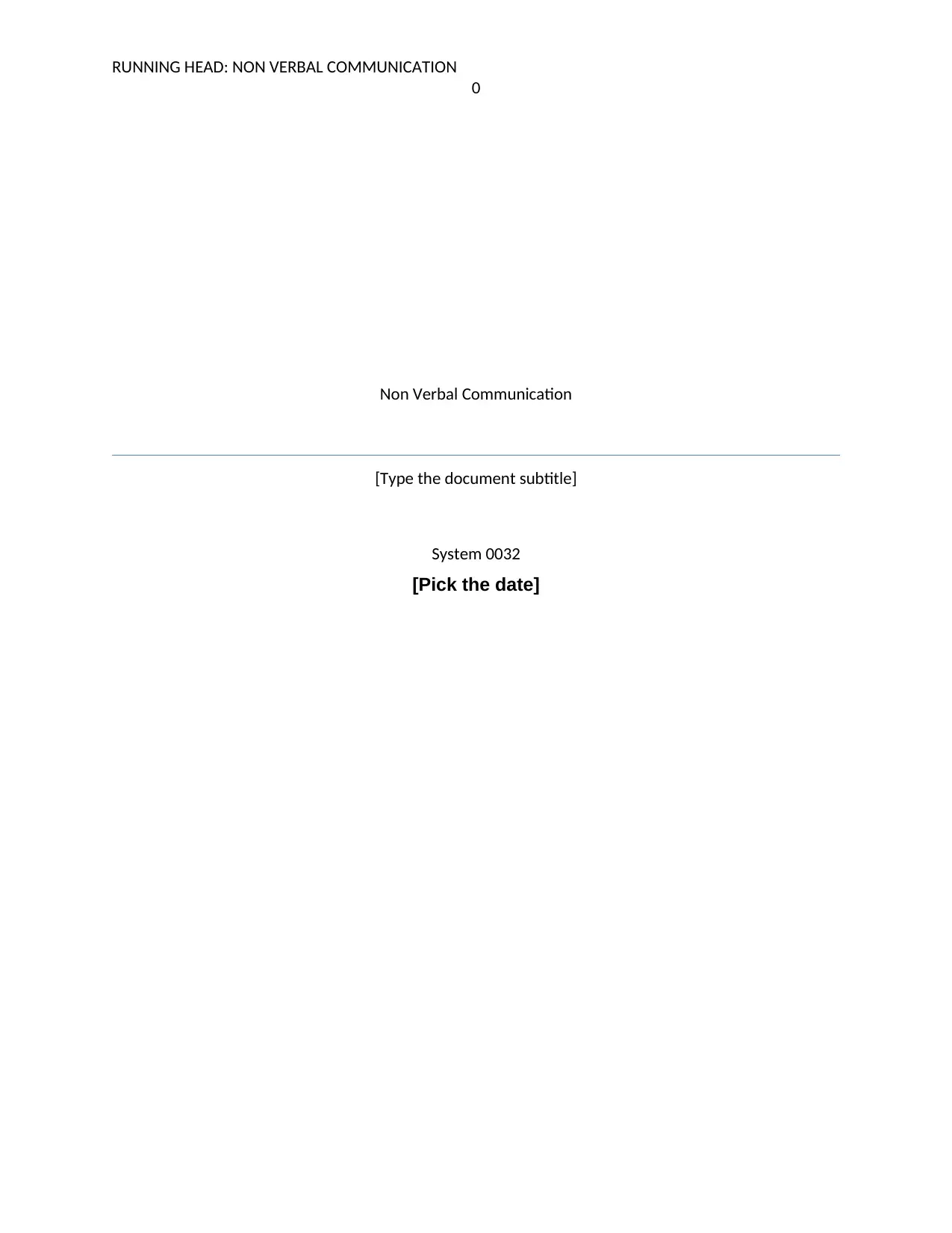
RUNNING HEAD: NON VERBAL COMMUNICATION
0
Non Verbal Communication
[Type the document subtitle]
System 0032
[Pick the date]
0
Non Verbal Communication
[Type the document subtitle]
System 0032
[Pick the date]
Secure Best Marks with AI Grader
Need help grading? Try our AI Grader for instant feedback on your assignments.
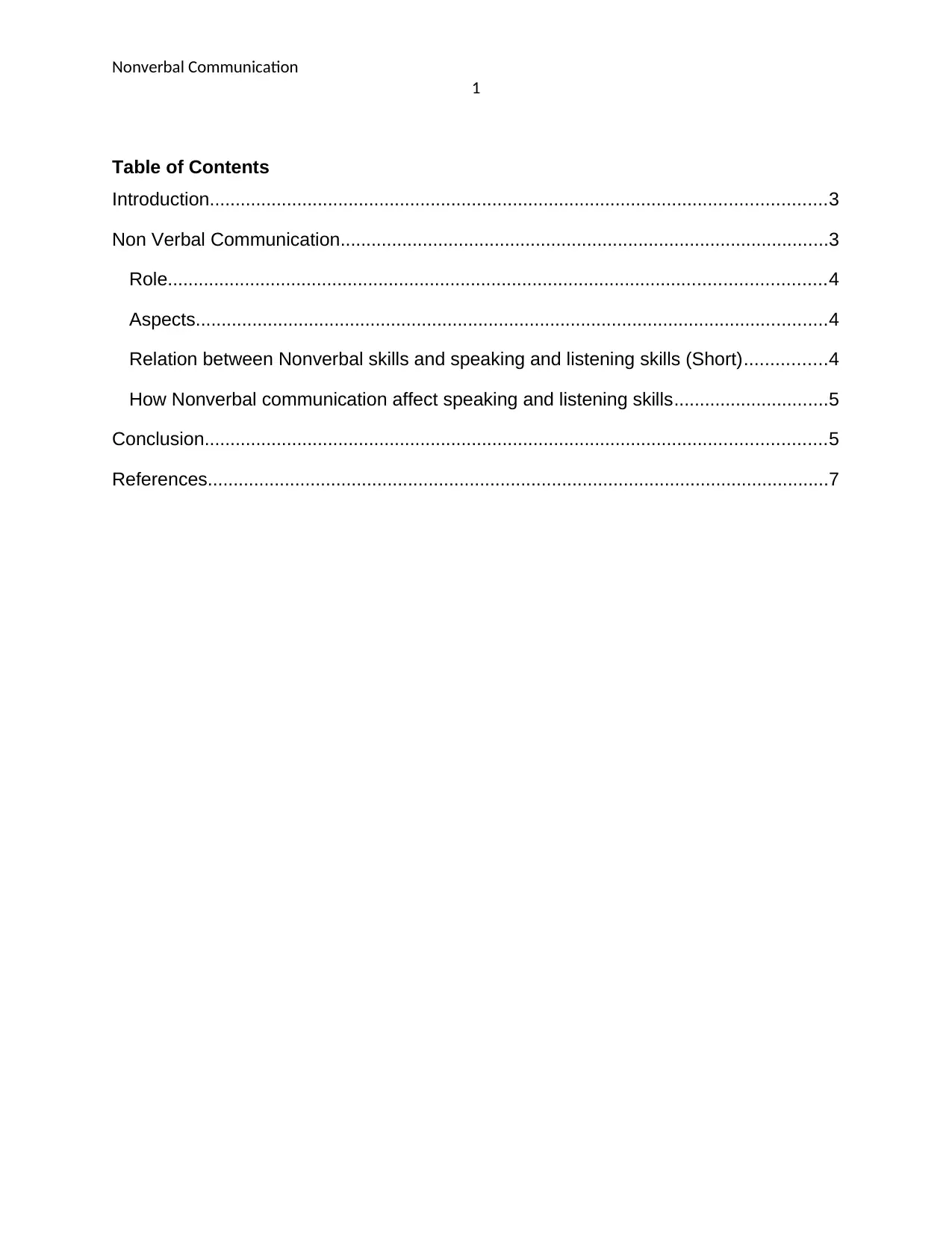
Nonverbal Communication
1
Table of Contents
Introduction........................................................................................................................3
Non Verbal Communication...............................................................................................3
Role................................................................................................................................4
Aspects...........................................................................................................................4
Relation between Nonverbal skills and speaking and listening skills (Short)................4
How Nonverbal communication affect speaking and listening skills..............................5
Conclusion.........................................................................................................................5
References.........................................................................................................................7
1
Table of Contents
Introduction........................................................................................................................3
Non Verbal Communication...............................................................................................3
Role................................................................................................................................4
Aspects...........................................................................................................................4
Relation between Nonverbal skills and speaking and listening skills (Short)................4
How Nonverbal communication affect speaking and listening skills..............................5
Conclusion.........................................................................................................................5
References.........................................................................................................................7
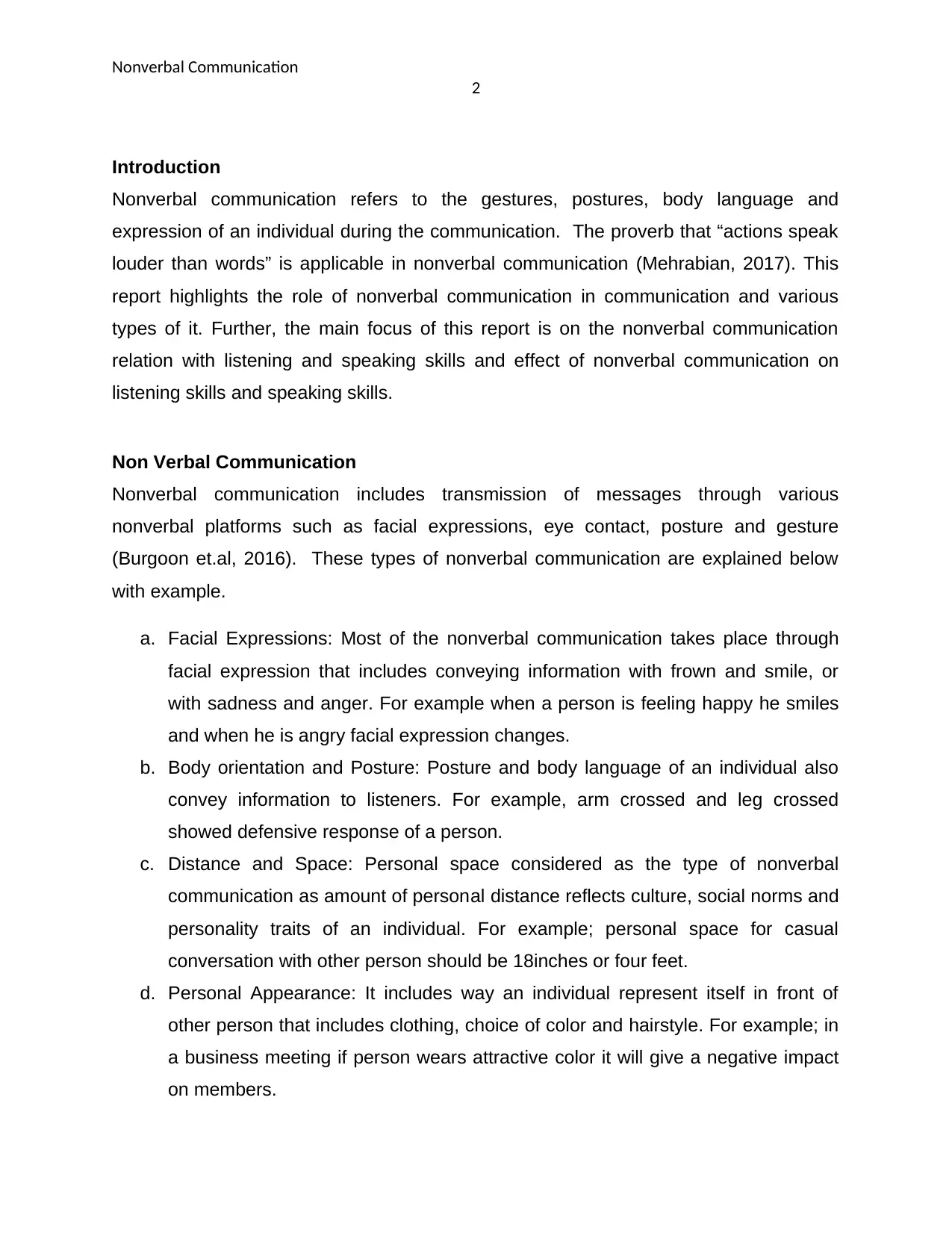
Nonverbal Communication
2
Introduction
Nonverbal communication refers to the gestures, postures, body language and
expression of an individual during the communication. The proverb that “actions speak
louder than words” is applicable in nonverbal communication (Mehrabian, 2017). This
report highlights the role of nonverbal communication in communication and various
types of it. Further, the main focus of this report is on the nonverbal communication
relation with listening and speaking skills and effect of nonverbal communication on
listening skills and speaking skills.
Non Verbal Communication
Nonverbal communication includes transmission of messages through various
nonverbal platforms such as facial expressions, eye contact, posture and gesture
(Burgoon et.al, 2016). These types of nonverbal communication are explained below
with example.
a. Facial Expressions: Most of the nonverbal communication takes place through
facial expression that includes conveying information with frown and smile, or
with sadness and anger. For example when a person is feeling happy he smiles
and when he is angry facial expression changes.
b. Body orientation and Posture: Posture and body language of an individual also
convey information to listeners. For example, arm crossed and leg crossed
showed defensive response of a person.
c. Distance and Space: Personal space considered as the type of nonverbal
communication as amount of personal distance reflects culture, social norms and
personality traits of an individual. For example; personal space for casual
conversation with other person should be 18inches or four feet.
d. Personal Appearance: It includes way an individual represent itself in front of
other person that includes clothing, choice of color and hairstyle. For example; in
a business meeting if person wears attractive color it will give a negative impact
on members.
2
Introduction
Nonverbal communication refers to the gestures, postures, body language and
expression of an individual during the communication. The proverb that “actions speak
louder than words” is applicable in nonverbal communication (Mehrabian, 2017). This
report highlights the role of nonverbal communication in communication and various
types of it. Further, the main focus of this report is on the nonverbal communication
relation with listening and speaking skills and effect of nonverbal communication on
listening skills and speaking skills.
Non Verbal Communication
Nonverbal communication includes transmission of messages through various
nonverbal platforms such as facial expressions, eye contact, posture and gesture
(Burgoon et.al, 2016). These types of nonverbal communication are explained below
with example.
a. Facial Expressions: Most of the nonverbal communication takes place through
facial expression that includes conveying information with frown and smile, or
with sadness and anger. For example when a person is feeling happy he smiles
and when he is angry facial expression changes.
b. Body orientation and Posture: Posture and body language of an individual also
convey information to listeners. For example, arm crossed and leg crossed
showed defensive response of a person.
c. Distance and Space: Personal space considered as the type of nonverbal
communication as amount of personal distance reflects culture, social norms and
personality traits of an individual. For example; personal space for casual
conversation with other person should be 18inches or four feet.
d. Personal Appearance: It includes way an individual represent itself in front of
other person that includes clothing, choice of color and hairstyle. For example; in
a business meeting if person wears attractive color it will give a negative impact
on members.
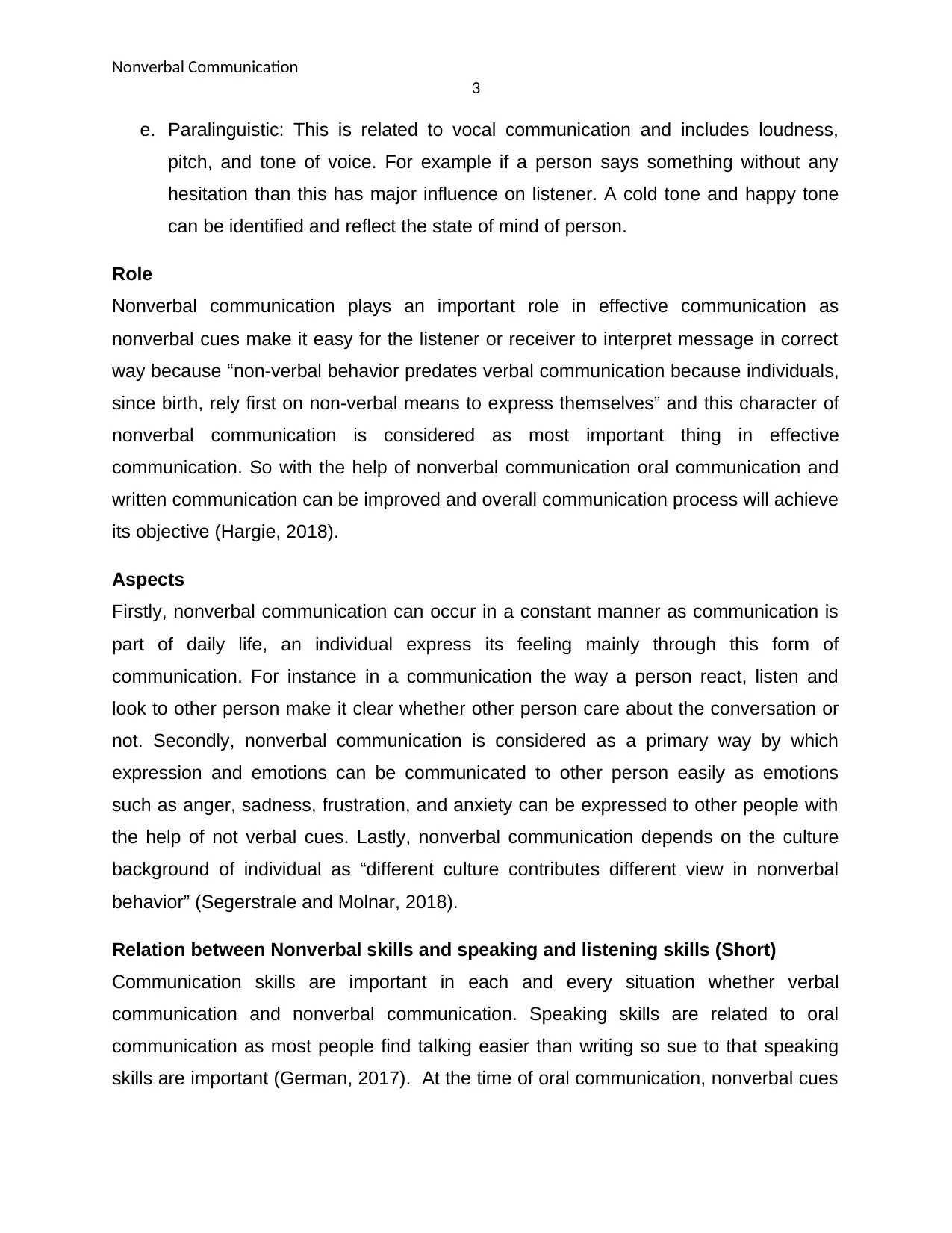
Nonverbal Communication
3
e. Paralinguistic: This is related to vocal communication and includes loudness,
pitch, and tone of voice. For example if a person says something without any
hesitation than this has major influence on listener. A cold tone and happy tone
can be identified and reflect the state of mind of person.
Role
Nonverbal communication plays an important role in effective communication as
nonverbal cues make it easy for the listener or receiver to interpret message in correct
way because “non-verbal behavior predates verbal communication because individuals,
since birth, rely first on non-verbal means to express themselves” and this character of
nonverbal communication is considered as most important thing in effective
communication. So with the help of nonverbal communication oral communication and
written communication can be improved and overall communication process will achieve
its objective (Hargie, 2018).
Aspects
Firstly, nonverbal communication can occur in a constant manner as communication is
part of daily life, an individual express its feeling mainly through this form of
communication. For instance in a communication the way a person react, listen and
look to other person make it clear whether other person care about the conversation or
not. Secondly, nonverbal communication is considered as a primary way by which
expression and emotions can be communicated to other person easily as emotions
such as anger, sadness, frustration, and anxiety can be expressed to other people with
the help of not verbal cues. Lastly, nonverbal communication depends on the culture
background of individual as “different culture contributes different view in nonverbal
behavior” (Segerstrale and Molnar, 2018).
Relation between Nonverbal skills and speaking and listening skills (Short)
Communication skills are important in each and every situation whether verbal
communication and nonverbal communication. Speaking skills are related to oral
communication as most people find talking easier than writing so sue to that speaking
skills are important (German, 2017). At the time of oral communication, nonverbal cues
3
e. Paralinguistic: This is related to vocal communication and includes loudness,
pitch, and tone of voice. For example if a person says something without any
hesitation than this has major influence on listener. A cold tone and happy tone
can be identified and reflect the state of mind of person.
Role
Nonverbal communication plays an important role in effective communication as
nonverbal cues make it easy for the listener or receiver to interpret message in correct
way because “non-verbal behavior predates verbal communication because individuals,
since birth, rely first on non-verbal means to express themselves” and this character of
nonverbal communication is considered as most important thing in effective
communication. So with the help of nonverbal communication oral communication and
written communication can be improved and overall communication process will achieve
its objective (Hargie, 2018).
Aspects
Firstly, nonverbal communication can occur in a constant manner as communication is
part of daily life, an individual express its feeling mainly through this form of
communication. For instance in a communication the way a person react, listen and
look to other person make it clear whether other person care about the conversation or
not. Secondly, nonverbal communication is considered as a primary way by which
expression and emotions can be communicated to other person easily as emotions
such as anger, sadness, frustration, and anxiety can be expressed to other people with
the help of not verbal cues. Lastly, nonverbal communication depends on the culture
background of individual as “different culture contributes different view in nonverbal
behavior” (Segerstrale and Molnar, 2018).
Relation between Nonverbal skills and speaking and listening skills (Short)
Communication skills are important in each and every situation whether verbal
communication and nonverbal communication. Speaking skills are related to oral
communication as most people find talking easier than writing so sue to that speaking
skills are important (German, 2017). At the time of oral communication, nonverbal cues
Secure Best Marks with AI Grader
Need help grading? Try our AI Grader for instant feedback on your assignments.
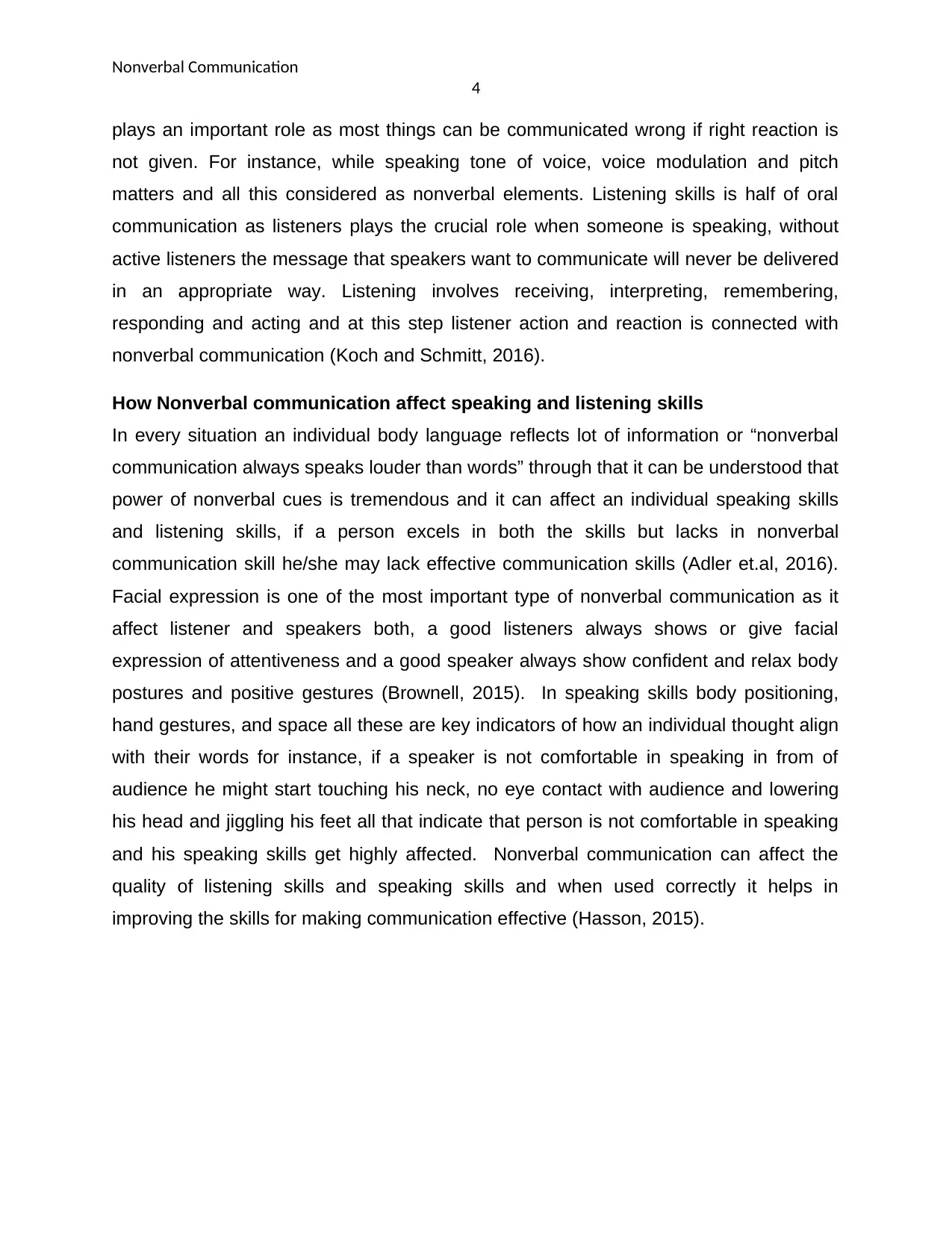
Nonverbal Communication
4
plays an important role as most things can be communicated wrong if right reaction is
not given. For instance, while speaking tone of voice, voice modulation and pitch
matters and all this considered as nonverbal elements. Listening skills is half of oral
communication as listeners plays the crucial role when someone is speaking, without
active listeners the message that speakers want to communicate will never be delivered
in an appropriate way. Listening involves receiving, interpreting, remembering,
responding and acting and at this step listener action and reaction is connected with
nonverbal communication (Koch and Schmitt, 2016).
How Nonverbal communication affect speaking and listening skills
In every situation an individual body language reflects lot of information or “nonverbal
communication always speaks louder than words” through that it can be understood that
power of nonverbal cues is tremendous and it can affect an individual speaking skills
and listening skills, if a person excels in both the skills but lacks in nonverbal
communication skill he/she may lack effective communication skills (Adler et.al, 2016).
Facial expression is one of the most important type of nonverbal communication as it
affect listener and speakers both, a good listeners always shows or give facial
expression of attentiveness and a good speaker always show confident and relax body
postures and positive gestures (Brownell, 2015). In speaking skills body positioning,
hand gestures, and space all these are key indicators of how an individual thought align
with their words for instance, if a speaker is not comfortable in speaking in from of
audience he might start touching his neck, no eye contact with audience and lowering
his head and jiggling his feet all that indicate that person is not comfortable in speaking
and his speaking skills get highly affected. Nonverbal communication can affect the
quality of listening skills and speaking skills and when used correctly it helps in
improving the skills for making communication effective (Hasson, 2015).
4
plays an important role as most things can be communicated wrong if right reaction is
not given. For instance, while speaking tone of voice, voice modulation and pitch
matters and all this considered as nonverbal elements. Listening skills is half of oral
communication as listeners plays the crucial role when someone is speaking, without
active listeners the message that speakers want to communicate will never be delivered
in an appropriate way. Listening involves receiving, interpreting, remembering,
responding and acting and at this step listener action and reaction is connected with
nonverbal communication (Koch and Schmitt, 2016).
How Nonverbal communication affect speaking and listening skills
In every situation an individual body language reflects lot of information or “nonverbal
communication always speaks louder than words” through that it can be understood that
power of nonverbal cues is tremendous and it can affect an individual speaking skills
and listening skills, if a person excels in both the skills but lacks in nonverbal
communication skill he/she may lack effective communication skills (Adler et.al, 2016).
Facial expression is one of the most important type of nonverbal communication as it
affect listener and speakers both, a good listeners always shows or give facial
expression of attentiveness and a good speaker always show confident and relax body
postures and positive gestures (Brownell, 2015). In speaking skills body positioning,
hand gestures, and space all these are key indicators of how an individual thought align
with their words for instance, if a speaker is not comfortable in speaking in from of
audience he might start touching his neck, no eye contact with audience and lowering
his head and jiggling his feet all that indicate that person is not comfortable in speaking
and his speaking skills get highly affected. Nonverbal communication can affect the
quality of listening skills and speaking skills and when used correctly it helps in
improving the skills for making communication effective (Hasson, 2015).
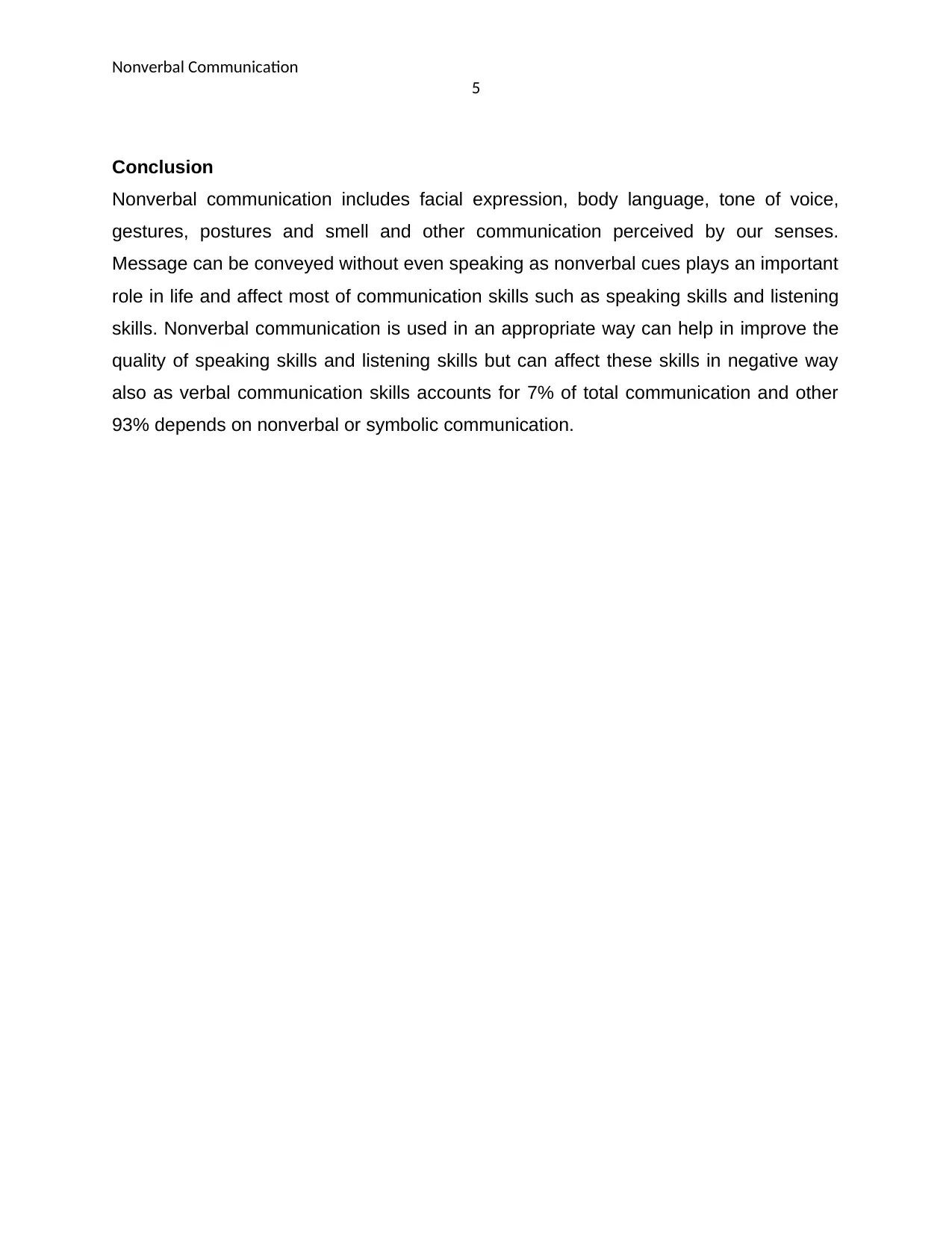
Nonverbal Communication
5
Conclusion
Nonverbal communication includes facial expression, body language, tone of voice,
gestures, postures and smell and other communication perceived by our senses.
Message can be conveyed without even speaking as nonverbal cues plays an important
role in life and affect most of communication skills such as speaking skills and listening
skills. Nonverbal communication is used in an appropriate way can help in improve the
quality of speaking skills and listening skills but can affect these skills in negative way
also as verbal communication skills accounts for 7% of total communication and other
93% depends on nonverbal or symbolic communication.
5
Conclusion
Nonverbal communication includes facial expression, body language, tone of voice,
gestures, postures and smell and other communication perceived by our senses.
Message can be conveyed without even speaking as nonverbal cues plays an important
role in life and affect most of communication skills such as speaking skills and listening
skills. Nonverbal communication is used in an appropriate way can help in improve the
quality of speaking skills and listening skills but can affect these skills in negative way
also as verbal communication skills accounts for 7% of total communication and other
93% depends on nonverbal or symbolic communication.
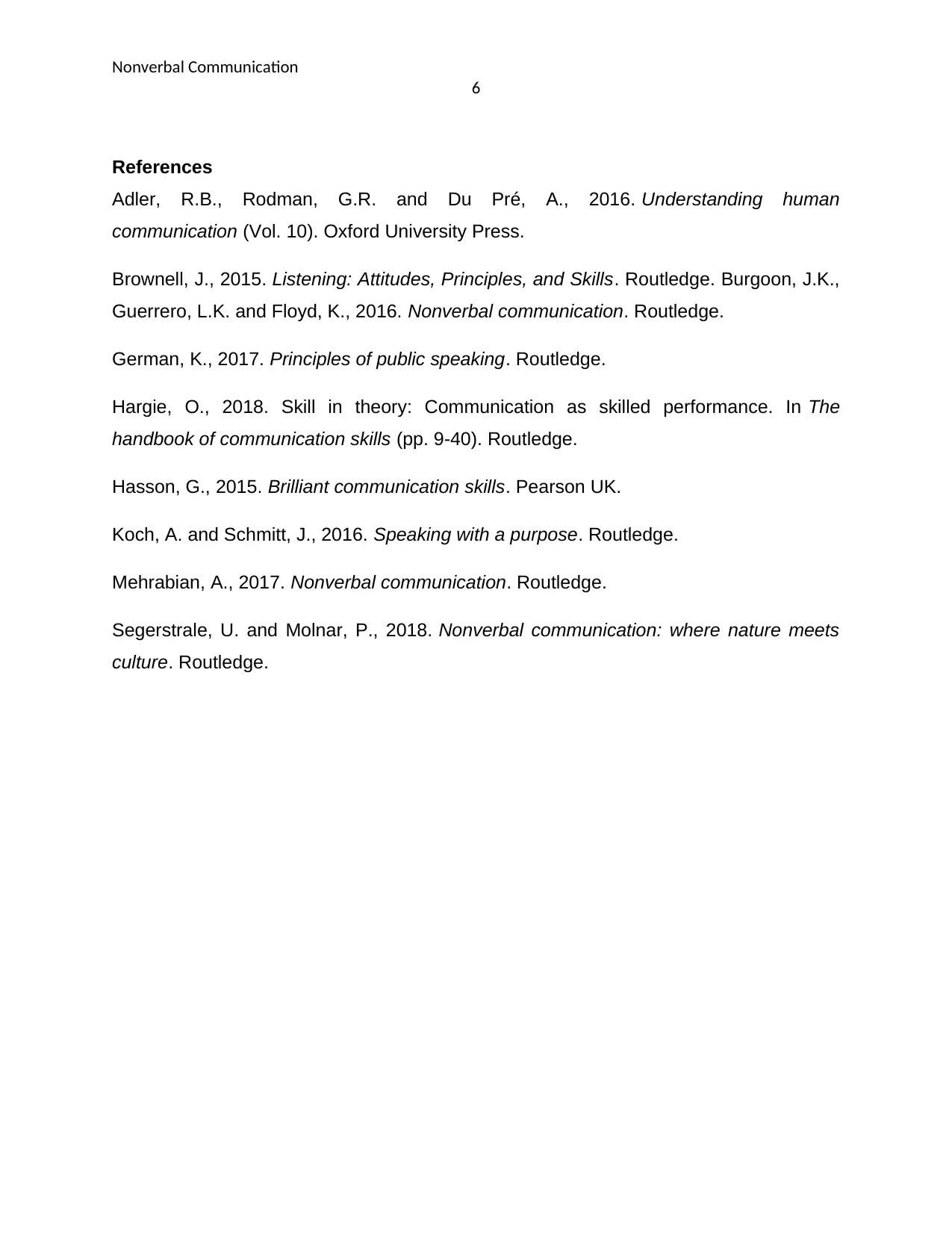
Nonverbal Communication
6
References
Adler, R.B., Rodman, G.R. and Du Pré, A., 2016. Understanding human
communication (Vol. 10). Oxford University Press.
Brownell, J., 2015. Listening: Attitudes, Principles, and Skills. Routledge. Burgoon, J.K.,
Guerrero, L.K. and Floyd, K., 2016. Nonverbal communication. Routledge.
German, K., 2017. Principles of public speaking. Routledge.
Hargie, O., 2018. Skill in theory: Communication as skilled performance. In The
handbook of communication skills (pp. 9-40). Routledge.
Hasson, G., 2015. Brilliant communication skills. Pearson UK.
Koch, A. and Schmitt, J., 2016. Speaking with a purpose. Routledge.
Mehrabian, A., 2017. Nonverbal communication. Routledge.
Segerstrale, U. and Molnar, P., 2018. Nonverbal communication: where nature meets
culture. Routledge.
6
References
Adler, R.B., Rodman, G.R. and Du Pré, A., 2016. Understanding human
communication (Vol. 10). Oxford University Press.
Brownell, J., 2015. Listening: Attitudes, Principles, and Skills. Routledge. Burgoon, J.K.,
Guerrero, L.K. and Floyd, K., 2016. Nonverbal communication. Routledge.
German, K., 2017. Principles of public speaking. Routledge.
Hargie, O., 2018. Skill in theory: Communication as skilled performance. In The
handbook of communication skills (pp. 9-40). Routledge.
Hasson, G., 2015. Brilliant communication skills. Pearson UK.
Koch, A. and Schmitt, J., 2016. Speaking with a purpose. Routledge.
Mehrabian, A., 2017. Nonverbal communication. Routledge.
Segerstrale, U. and Molnar, P., 2018. Nonverbal communication: where nature meets
culture. Routledge.
1 out of 7
Your All-in-One AI-Powered Toolkit for Academic Success.
+13062052269
info@desklib.com
Available 24*7 on WhatsApp / Email
![[object Object]](/_next/static/media/star-bottom.7253800d.svg)
Unlock your academic potential
© 2024 | Zucol Services PVT LTD | All rights reserved.




